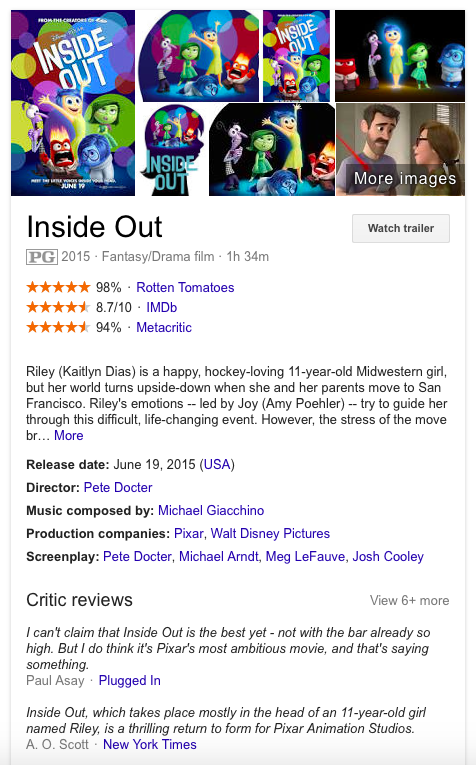INSIDE OUT
To start, I want to share my emotional reaction to the movie. I think watching the inner working of the mind, in specifically regards to a child growing up, touched me and moved me on a deep level. I was often crying, tearing up, and moved with deep emotions of joy and sadness. I did not experience much disgust or anger. I also had some uncontrolled and spontaneous laughter. The conflict portion of the movie seemed so life-like, after working with people with depression. In the movie, depression was illustrated by happy memories being colored as sad, by core personality components breaking apart and by a dominance of anger, disgust and fear. Finally depression progressed to numbness, in which the emotions had little ability to communicate with the outside world at all. I was pulled into the plot and found myself yearning for joy to return to the main character. I found myself full of tension due to my role as a parent, and also imagining a similar struggle in my patients. In the end, I found the conclusion gratifying and relieving of my tension. I pictured sweet moments with my family in a similar light, and the complexities of the inner workings of the mind added such depth to such memories.
Here are some of my thoughts on things I appreciated about the movie:
Emotions, like sadness, found a purpose. Sadness rightly placed reestablished connection with the family. Sadness’ purpose also shined through when empathizing with another’s sadness. When empathy was experienced, the characters were able to keep moving forward.
My thoughts on the potential place for emotions:
- Contempt or Smug transformed could be when your child makes moves towards independence and love towards others. It could also be when you bless another and see them succeeding more than you.
- Sadness transformed will allow us to experience loss when another experiences a loss
- Disgust transformed will give us a revulsion at others being wronged
- Happiness transformed rejoices with others’ successes and blessings, as well as seeing others as your teachers and trials as ways to move forward…
- Fear transformed will be concern for others in a way that saves them from suffering
- Anger transformed will be a strong feeling of justice to protect the helpless
Emotions work best in concert… Emotions go off all the time, often outside our awareness. When they are playing their tones together, in synergy, it creates beautiful music. In the movie, the emotions (which are played by different personalities) each needed to mature in their own way. And as they matured they seemed to work together.
Depression seemed to be an absence or a missing of emotions. I find this to be true. We almost have to find sadness, experience anger, and understand fear before moving onto joy. At one part of the movie, the emotions lose their powers and have no ability to move forward without sadness. I find that sometimes this is counterintuitive to think that it might have a purpose to feel with another’s emotions, to enter into someone’s sadness, or to feel with someone’s anger. But then it happens. Sitting with someone, feeling with them or feeling felt by them, connection occurs. Connection almost moves us into another state. Something is pulled from one heart to another.
In conclusion, I would highly recommend that you watch the movie. I also think in terms of connection, it is important to understand your emotions, be able to hear their goals and purposes, and to be able to engage other’s emotions in a similar way. This movie hopefully will help kids gain the ability to understand their emotions. I am really excited about the possibilities of a sequel. How I wish I could be apart of the creative process of writing it!


